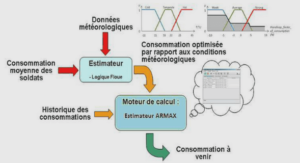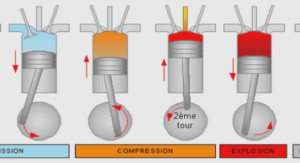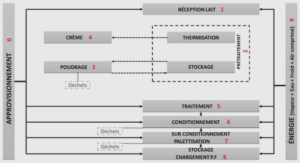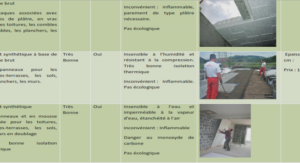RADIOLYSE DES POLYMERES A BASE DE FLUORURE DE VINYLIDENE
INTRODUCTION
L’étude de la radiolyse des matériaux polymères est encore aujourd’hui associée à d’illustres noms tels que Chapiro, Charlesby et Pinner, qui se sont attachés à décrire, dès les années 60, l’évolution de la structure des chaines macromoléculaires lorsqu’elles sont soumises à un rayonnement ionisant. A partir de mesures macroscopiques, typiquement des fractions de gel, ils ont réussi à déterminer les rendements de scission et de réticulation de différentes matrices et ont ainsi posé les bases de la compréhension des mécanismes radicalaires mis en jeu pendant l’irradiation des polymères. Néanmoins, si l’on souhaite sonder et caractériser les évènements induits dans la matrice et notamment les coupures de liaisons, d’autres techniques d’analyses sont nécessaires. La Résonance Paramagnétique Electronique (RPE) devient alors une technique de choix puisqu’elle permet d’analyser les électrons non appariés des radicaux. L’aspect quantitatif de la méthode la rend très attractive ; on peut par exemple déterminer la quantité de radicaux disponibles pour amorcer une réaction de greffage suivant une chimie radicalaire. De plus, l’allure du signal RPE étant directement liée à la structure du radical (atomes présents en position α et β), il est également possible d’identifier la structure chimique des espèces radicalaires formées lors de l’irradiation ainsi que leurs proportions respectives. On comprend alors que l’utilisation de cette technique constitue une base solide et incontournable pour la compréhension des mécanismes mis en jeu lors du processus d’irradiation. Néanmoins, la démarche associée nécessite de connaitre les espèces radicalaires susceptibles d’être formées ainsi que leur signaux RPE respectifs. Dans cette partie, une première section est consacrée à l’établissement d’un modèle de simulation de spectres RPE des radicaux formés lors de l’irradiation du PVDF sous atmosphère inerte. Celui-ci permet, entre autres, de déterminer la concentration de chaque espèce radicalaire. La véracité et la robustesse du modèle seront discutées à travers l’étude de l’influence d’un recuit sur la proportion des radicaux (Partie I). Fort de ce modèle, la section suivante sera consacrée à l’étude de l’évolution de la concentration de chaque espèce radicalaire en fonction de différents paramètres expérimentaux, liés à l’étape d’irradiation (tel que la dose d’irradiation) ou post-irradiation (tel que le temps de recuit). Les tendances observées seront mise en relation avec la réactivité de chaque espèce ainsi qu’avec la formation et la densification d’un réseau induites par la recombinaison des radicaux (Partie II). Enfin, le modèle de simulation sera étendu au cas du copolymère p(VDF-coHFP) au cours de la dernière section. Nous montrerons son utilité ainsi que ses limites (Partie III).
ELECTRON SPIN RESONANCE QUANTITATIVE MONITORING OF FIVE DIFFERENT RADICALS IN 𝛾- IRRADIATED POLYVINYLIDENE FLUORIDE
The complex superimposition of electron spin resonance (ESR) signals of the five different radicals generated on PVDF upon γ-rays exposure are fully simulated for the first time, including g factors as well as aα and aβ hyperfine splitting constants of proton or fluorine in α or β positions from the radical. The starting parameters were selected based on a thorough literature survey on their better-known fluorocarbons and perhydrogenated radical analogues and discussed in terms of correspondence with radicals in PVDF. Particularly, the electronegativity difference between F and H atoms is taken into account since it directly affects the electron delocalization in the radical. The finally obtained ESR parameters are consistent with the spectroscopic characteristics and the chemical stability of the radicals. Since radical absolute concentration for each radical is accessible, the simulation was also applied to monitor their stability upon annealing for different exposure times at 373K. The resulting trend is in full adequacy with the expected relation between electron delocalization, mobility and stability.
INTRODUCTION
Exposition to high γ-irradiation doses is most of the case lethal to living systems and creates also more or less reversible damages to inert matter during nuclear accidents, uncontrolled transportation of radionuclide or merely to containers designed for ionizing radiation protection.1 Such most often damages appear as radicals that chemists or biochemists may also used in a positive way for quality control and even more interesting to modify materials. In all the cases, identification and quantization of these radicals are mandatory to further develop environment friendly applications. Indeed, irradiation is already a well-developed technique to modify surface or bulk properties, eventually a cost-effective way for sterilization of materials dedicated to food or biomedical fields, and has been an interesting alternative for chemical modifications of polymeric materials through irradiation-induced grafting strategies.2 Polymers radiolysis mechanisms are relatively well known3 and lead to the formation of free radicals through the cleavage of covalent bonds and chemical rearrangement. As a consequence, irradiation causes crosslinking, chain scission, rearrangement, etc… Although most of these events are quite fast, in semi-crystalline polymers, transients such as radicals can survive for hours. Moreover, even for very simple chemical structure, irradiation of polymers leads to multiple radical species which the relative concentration depends on experimental parameters such as dose, thermal history or environment.3 Electron spin resonance (ESR), also known as EPR (electron paramagnetic resonance) is a powerful characterization technique providing not only information on the chemical structure of the radicals but also spin concentration, i.e., quantization.4 However, s and p type radicals are restrained in a narrow range of spectral response that leads to the superimposition of all the signals and each of them are most often made of several peaks. The signals are so complex that it is difficult to fully interpret without simulating the overall ESR response. Nonetheless, reasonable solution cannot be found without a priori knowledge of each radical ESR parameters such as the symmetry of the g tensor and the hyperfine tensor. Because of their intrinsic properties such as chemical inertness in a wide range of solvents, stabilities at high temperature, piezo-and pyroelectric properties and so forth, poly(vinylidene fluoride) PVDF is an interesting polymer which applications lay from medical suture wires, filtration membranes, separators for lithium-ion batteries etc…5 However, to perfectly meet the requirements of a given application, mechanical or surface properties have to be adapted and enhanced. Irradiation-induced chemical changes have lately been a relevant strategy for that purpose as it can be applied after the polymer has been processed. According to simple energetic considerations, each covalent bond of the VDF repeating unit can be broken when the material is exposed to ionizing radiations. C-F, C-H and C-C bond energies are respectively 4.42, 4.28 and 3.44 eV,6 which values are very weak compared to gamma photon energies lying in the keV order of magnitude. A random bond scission results 7 and leads to five different types of free radicals as suggested by Makuuchi 8 in the early 70s. −(𝐶𝐹 = 𝐶𝐻)𝑛 − 𝐶̇ 𝐹 − (I) ; −𝐶𝐹2 − 𝐶̇ 𝐻 − 𝐶𝐹2 − (II) ; −𝐶𝐻2 − 𝐶̇ 𝐹 − 𝐶𝐻2 − (III) ; −𝐶𝐹2 − 𝐶̇ 𝐻2 (IV) ; −𝐶𝐻2 − 𝐶̇ 𝐹2 (V). Figure 1. List of radicals generated in irradiated PVDF according to ref. 8 So far, there is no study yet which presents a full ESR signal simulation comprising these five species and monitoring their intensity depending on conditions of irradiation. Indeed, radicals (I) and (II) are the best documented species with generally accepted ESR parameters. On the contrary, there are obvious discrepancies regarding the ESR parameters of radicals (III), (IV) and (V). Because of the complexity of each signal and their superimposition in the same spectral range, it is important to start the simulation with reasonable g and A tensor and verify that a given set of parameters applies to a variety of irradiation and post treatment conditions. Educated guess on these parameters can conveniently rely on analogue species generated in other polymers. This is the approach applied here to simulate the ESR spectrum of γ-irradiated PVDF at a radiation dose of 150 kGy.
EXPERIMENTAL METHODS
Samples of commercially available K741 PVDF (Arkema, France) with 𝑀𝑛 ���� = 110 000 g/mol as determined by GPC in DMF were used. Powder was compacted and introduced into 5mm Suprasil quartz ESR tubes mounted with a glass valve. Samples were vacuumed at room temperature, intermittently purged with argon and finally kept under argon atmosphere. The mounted tubes were placed into another vacuum bell under argon to prevent from any oxygen contamination. Irradiations were carried out using an industrial 60Co gamma source at room temperature (300K) with dose rate of 0.7 kGy.h-1. Irradiated samples were then kept at 255K until they were studied to prevent any radical decay. ESR spectra were recorded on a Bruker ELEXSYS E500 spectrometer operating in the X band microwave frequency range with a liquid nitrogen temperature controller. All spectra were acquired at 255K using a modulation amplitude of 0.1 mT, an optimum microwave power of 1.013 mW, a center field of 335 mT, and a sweep width of 40 mT. [L. Dumas], [2012], INSA de Lyon, tous droits réservés Residual quartz signal was removed by a simple subtraction. Radical concentrations were calculated from the double integration of the first absorption derivative spectrum, using a calibration curve built up from a series of chloroform solutions of diphenylpicrylhydrazine (DPPH) with known concentrations. A freeware ESR simulator, i.e. WinSIM 2002 program 38 was used to correlate experimental and simulated spectrum taking into account hyperfine splitting constants, g values, signal lineshape and signal linewidth. The simulated ESR spectrum is optimized using the downhill simplex algorithm of WinSIM program. Sol-gel analyses were performed in DMF. About 1 g of sample was used. Sample weight was determined accurately (wi) and a large excess of solvent (60 mL) was added. The solution was heated at 353K for 48 h to allow the complete extraction of the soluble component. Swollen gels were weighted at 353K (wg). The swollen samples had been carefully wiped with a tissue before any weighing. The solvent was then evaporated under vacuum for 24 h at 373K to determine the weight of dried gel (wdg). The gel content (% gel) was calculated using the following equation: %𝑔𝑒𝑙 = 𝑤𝑑𝑔 𝑤𝑖 × 100 .




